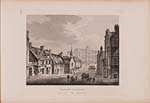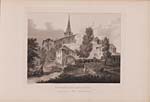(31) Plate XIII/a
Download files
Individual page:
Thumbnail gallery: Grid view | List view

Plate XIII.
DUNFERMLINE ABBEY.
THE town of Dunfermline,
in, or rather close to, which the ruins of this Abbey remain, is in
the
county of Fife, and at a short distance from Edinburgh. It became,
at a very early period, a residence for
the Scottish monarchs, and Malcolm III, surnamed Canmore, resided
in a tower, or castle, built on a
peninsulated hill in the glen. A palace was afterwards erected a
little to the south-east of the town, in
a situation truly romantic. The walls of this are still standing,
and tradition continues to point out
the chimney of the apartment, where the unfortunate Charles I. was
born.
The monastery, or abbey,
is said to be one of the oldest in Scotland, and was founded by
Malcolm
Canmore, for the monks of St. Benedict. He left, however, the
building unfinished, and it was com-
pleted by his son Alexander I. Until the reign of David I, it was
governed by a prior; but he raised it
to the dignity of an abbey, and in 1124, translated thither
thirteen monks from Canterbury. These were
increased to twenty-six at the time of the dissolution. The first
person, who was appointed abbot, was
Gosfridus, and the last, George Ducie. The whole of these buildings
were both extensive and magni-
ficent, but were almost entirely destroyed in the fourteenth
century by the English. In 1303, Edward I.
took up his winter quarters at Dunfermline. "In that place," says
Hailes, "there was an abbey of the
Benedictine order; a building so spacious, that three sovereign
princes, with all their retinue, might have
been lodged conveniently within its walls." The ruins of the Abbey
are not now very extensive, but
there is still a window belonging to what is called the
Frater-hall, remarkable for its size and beauty.
The church is not quite so ruinous. It was built at the same time,
and indeed forms a part of the abbey
itself, by Malcolm Canmore; and is said to have been in a similar
style of architecture to Durham Cathedral.
Part of it is at present used for Divine service, but it is very
small, inconvenient, and uncomfortable.
It was to this place,
that Malcolm transferred the royal cemetery from the Island of
Iona, or Icolmkill:
himself, his queen, and seven other monarchs were buried
here.
This view, which was made
in 1799, is taken from a field on the Pittencrief side, and with
the ruins,
partly obscured by the smoke, arising from the drying-house of the
mill in front, with the water running
from the wheel, forms a most pleasing scene.—Almost every corn-mill
in Scotland has a kiln or drying-
house, attached to it, where the corn is constantly dried, previous
to its being ground.
Set display mode to:
![]() Universal Viewer |
Universal Viewer | ![]() Mirador |
Large image | Transcription
Mirador |
Large image | Transcription
Images and transcriptions on this page, including medium image downloads, may be used under the Creative Commons Attribution 4.0 International Licence unless otherwise stated. ![]()
| Scotia depicta > (31) Plate XIII/a |
|---|

